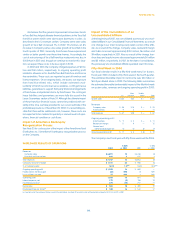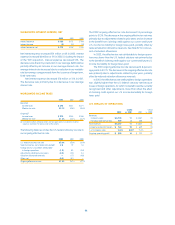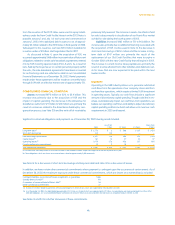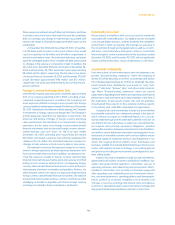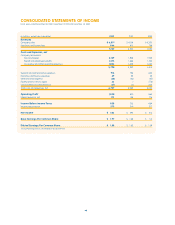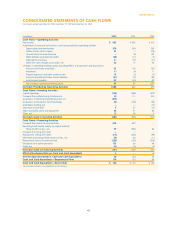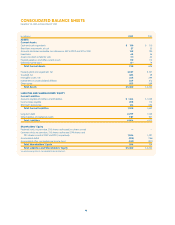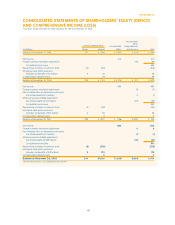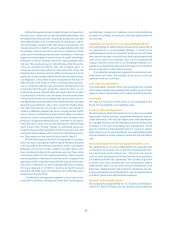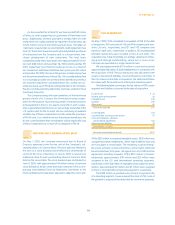Pizza Hut 2002 Annual Report Download - page 45
Download and view the complete annual report
Please find page 45 of the 2002 Pizza Hut annual report below. You can navigate through the pages in the report by either clicking on the pages listed below, or by using the keyword search tool below to find specific information within the annual report.
These swaps are entered into with financial institutions and have
reset dates and critical terms that match those of the underlying
debt. Accordingly, any change in market value associated with
interest rate swaps is offset by the opposite market impact on the
related debt.
At December 28, 2002 and December 29, 2001, a hypothet-
ical 100 basis point increase in short-term interest rates would
result in a reduction of $6 million and $4 million, respectively, in
annual income before taxes. The estimated reductions are based
upon the unhedged portion of our variable rate debt and assume
no changes in the volume or composition of debt. In addition, the
fair value of our derivative financial instruments at December 28,
2002 and December 29, 2001 would decrease approximately
$8 million and $5 million, respectively. The fair value of our Senior
Unsecured Notes at December 28, 2002 and December 29, 2001
would decrease approximately $93 million and $72 million,
respectively. Fair value was determined by discounting the pro-
jected cash flows.
Foreign Currency Exchange Rate Risk
International ongoing operating profit constitutes approximately
32% of our ongoing operating profit in 2002, excluding unallo-
cated and corporate expenses. In addition, the Company’s net
asset exposure (defined as foreign currency assets less foreign
currency liabilities) totaled approximately $1 billion as of December
28, 2002. Operating in international markets exposes the Company
to movements in foreign currency exchange rates. The Company’s
primary exposures result from our operations in Asia-Pacific, the
Americas and Europe. Changes in foreign currency exchange
rates would impact the translation of our investments in foreign
operations, the fair value of our foreign currency denominated
financial instruments and our reported foreign currency denom-
inated earnings and cash flows. For the fiscal year ended
December 28, 2002, operating profit would have decreased
$43 million if all foreign currencies had uniformly weakened 10%
relative to the U.S. dollar. The estimated reduction assumes no
changes in sales volumes or local currency sales or input prices.
We attempt to minimize the exposure related to our invest-
ments in foreign operations by financing those investments with
local currency debt when practical. In addition, we attempt to min-
imize the exposure related to foreign currency denominated
financial instruments by purchasing goods and services from third
parties in local currencies when practical. Consequently, foreign
currency denominated financial instruments consist primarily of
intercompany short-term receivables and payables. At times, we
utilize forward contracts to reduce our exposure related to these
foreign currency denominated financial instruments. The notional
amount and maturity dates of these contracts match those of the
underlying receivables or payables such that our foreign currency
exchange risk related to these instruments is eliminated.
Commodity Price Risk
We are subject to volatility in food costs as a result of market risk
associated with commodity prices. Our ability to recover increased
costs through higher pricing is, at times, limited by the competitive
environment in which we operate. We manage our exposure to
this risk primarily through pricing agreements as well as, on a lim-
ited basis, commodity future and option contracts. Commodity
future and option contracts entered into for the fiscal years ended
December 28, 2002, and December 29, 2001, did not significantly
impact our financial position, results of operations or cash flows.
CAUTIONARY STATEMENTS
From time to time, in both written reports and oral statements, we
present “forward-looking statements” within the meaning of
Section 27A of the Securities Act of 1933, as amended, and Section
21E of the Securities Exchange Act of 1934, as amended. The state-
ments include those identified by such words as “may,” “will,”
“expect,” “anticipate,” “believe,” “plan” and other similar terminol-
ogy. These “forward-looking statements” reflect our current
expectations regarding future events and operating and financial
performance and are based upon data available at the time of
the statements. Actual results involve risks and uncertainties,
including both those specific to the Company and those specific
to the industry, and could differ materially from expectations.
Company risks and uncertainties include, but are not limited
to, potentially substantial tax contingencies related to the Spin-off,
which, if they occur, require us to indemnify PepsiCo, Inc.; our sub-
stantial debt leverage and the attendant potential restriction on
our ability to borrow in the future, as well as our substantial inter-
est expense and principal repayment obligations; potential
unfavorable variances between estimated and actual liabilities;
our ability to secure distribution of products and equipment to our
restaurants on favorable economic terms and our ability to ensure
adequate supply of restaurant products and equipment in our
stores; the ongoing financial viability of our franchisees and
licensees; volatility of actuarially determined losses and loss esti-
mates; and adoption of new or changes in accounting policies
and practices including pronouncements promulgated by stan-
dard setting bodies.
Industry risks and uncertainties include, but are not limited to,
global and local business, economic and political conditions; leg-
islation and governmental regulation; competition; success of
operating initiatives and advertising and promotional efforts;
volatility of commodity costs; increases in minimum wage and
other operating costs; availability and cost of land and construc-
tion; consumer preferences, spending patterns and demographic
trends; political or economic instability in local markets and
changes in currency exchange and interest rates; any adverse
economic or operational repercussions from terrorist activities and
any governmental response thereto; and war or risk of war.
43.
Yum! Brands Inc.


